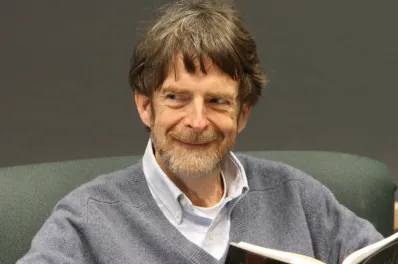Medievalist Craig Williamson Conjures Riddles for Hollywood's The Hobbit

It is from the dark goblin caves of chapter four that Bilbo Baggins, titular character of J.R.R. Tolkien's The Hobbit, awakens to discover that he is alone and lost. His only hope is the dark creature Gollum, who concocts a game of riddles to decide the fate of their respective journeys. If Gollum stumps Bilbo, the hobbit will be eaten, but if Bilbo stumps Gollum, the mischievous creature will have to show him the way out.
Gollum's riddles are dark and somewhat depressing, while Bilbo's riddles are more light-hearted - telling us much about their sense of purpose in the world, according to Alfred H. and Peggi Bloom Professor of English Literature Craig Williamson, coordinator of Swarthmore's Honors and Medieval Studies Programs.
Williamson, editor of the definitive edition of The Old English Riddles of the Exeter Book, was recently presented with a riddling task of his own. Although the stakes weren't quite as high as those faced by Bilbo Baggins, the challenge was lofty nonetheless: Warner Brothers invited him to submit a series of riddles to help promote The Hobbit: An Unexpected Journey. The film, part one of a highly anticipated trilogy, opens Dec. 14.
The invitation came at the suggestion of fellow medievalist Tom Shippey, literary consultant for all of the Tolkien films, who wrote the foreword to Williamson's new translation of Beowulf and Other Old English Poems. Williamson is also the author of A Feast of Creatures, in which he recasts nearly 100 Old English riddles of the Exeter Book into modern verse, with commentary and cultural contexts.
The origin of riddles and their specific context in medieval life remains largely a mystery. However, it appears that riddles, whether in Old English texts or the works of Tolkien, share a common affinity for clever metaphoric language.
To craft a good riddle, "you have to give a hint that is not immediately understood and those hints have to pile on top of each other," Williamson says. "The hints have to make sense, of course. Some are literally true. Some are metaphorically true."
It is up to the riddle-solver to determine what is what - a talent that is not universally mastered, Williamson admits. "Some people are definitely better at it than others," he says. "Little kids seem to be better at not just writing them, but solving them. As we grow up, we learn to put things in categories, but little kids haven't learned all the categories yet. Solving riddles is a way of reordering your perceptions. They force you to look at things in a different way, which is what makes solving them so beneficial."
When presented with a riddle, Williamson suggests the potential solver look at all the clues and all the possibilities of what they mean - a bird may be a bird, for example, or a bird may symbolize feathers, or flight. It may seem the opportunities for solutions are daunting, but when all the clues gather together, there is ultimately a correct answer.
"The best riddle-solver is a good riddle-writer who knows the art of riddle-deception and can see through the disguise of the creature to its real nature," Williamson says.
The difficulty of a particular riddle isn't necesarily what makes it clever, according to Williamson. The language and lyrical quality are what count. One of the easier of Williamson's 16 provided riddles is also among the most lyrical:
I am the maker of something sweet
For tea or toast, a morning treat.
I fly from stalk to stem for hours,
Collecting dust of summer flowers.
I'll give you some gold to gobble down
Or a needled kiss to make you frown.
"Some riddles can be lovely, even if they're easy," Williamson said.
All of Williamson's riddles - including the answer to the one above - are available at the riddles section of The Hobbit website.



